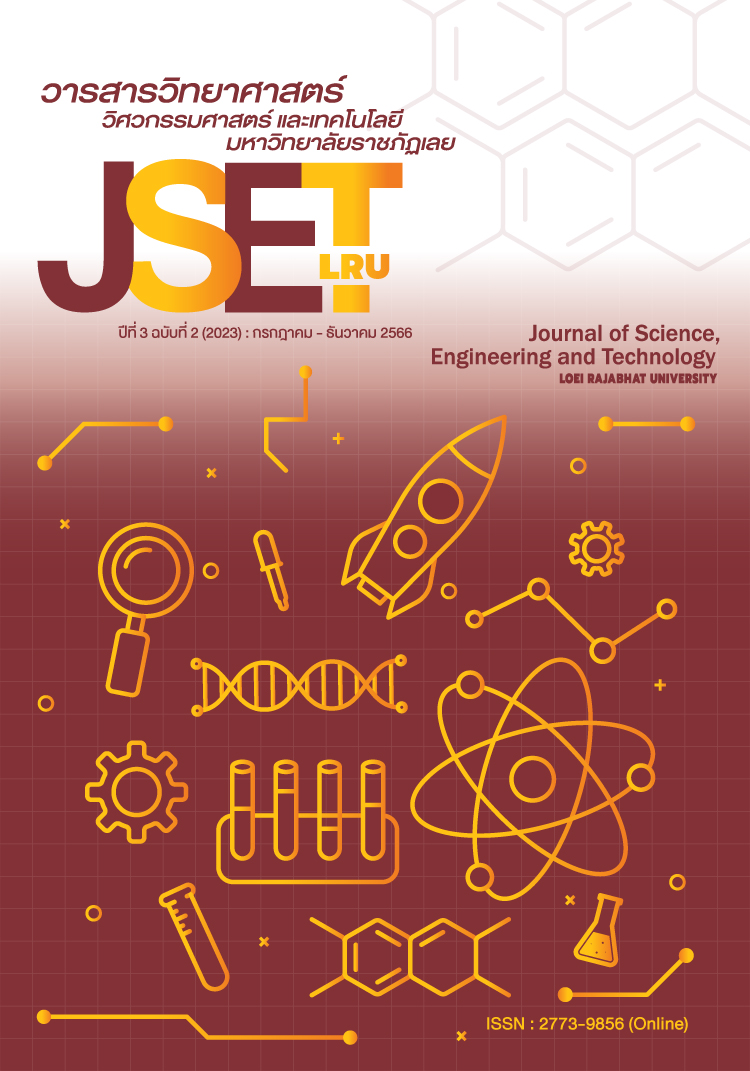ปฏิกิริยาควบแน่นแบบอัลดอลของอะซีโตนกับบิวทิรัลดีไฮด์ ด้วยตัวเร่งปฏิกิริยาอัลคาไลบนไฮโดรทัลไซต์
คำสำคัญ:
ออกไซด์ที่ได้จากไฮโดรทัลไซต์, การปรับสภาพทางความร้อน, โลหะอัลคาไลที่ได้รับการเติมแต่ง, การควบแน่นแบบอัลดอลบทคัดย่อ
ตัวเร่งปฏิกิริยาไฮโดรทัลไซต์ที่ได้รับการปรับสภาพด้วยความร้อนซึ่งถูกเตรียมที่อุณหภูมิแตกต่างกัน (HT400, HT600 และ HT 800) และโลหะอัลคาไล (ลิเทียม โพแทสเซียม และซีเซียม) ที่เติมแต่งใน HT400 ถูกศึกษาความแตกต่างของสมบัติเชิงพื้นผิว และประสิทธิภาพการเร่งปฏิกิริยา/ความสามารถในการเลือกสรรผลิตภัณฑ์ในปฏิกิริยาการควบแน่นแบบอัลดอลในสถานะแก๊สในระบบต่อเนื่องระหว่างอะซีโตนและบิวทิรัลดีไฮด์ ตัวเร่งปฏิกิริยาที่สังเคราะห์ขึ้นถูกวิเคราะห์คุณลักษณะด้วยเทคนิคการเลี้ยวเบนรังสีเอกซ์ กล้องจุลทรรศน์อิเล็กตรอนแบบส่องกราดซึ่งต่อกับสเปคโทรสโคปีรังสีเอกซ์แบบการกระจายพลังงาน และการโปรแกรมอุณหภูมิเพื่อศึกษาการคายซับคาร์บอนไดออกไซด์ ประสิทธิภาพการเร่งปฏิกิริยาของไฮโดรทัลไซต์ที่ได้รับการปรับสภาพด้วยความร้อนเพิ่มขึ้นตามลำดับต่อไปนี้: HT400 < HT600 < HT800 โดยปฏิกิริยาการควบแน่นแบบอัลดอลแบบข้าม และด้วยตัวเองทำให้เกิดส่วนผสมของผลิตภัณฑ์ควบแน่นหลายชนิด ในปฏิกิริยาการควบแน่นแบบอัลดอลระหว่างอะซีโตนและบิวทิรัลดีไฮด์โดยใช้ตัวเร่งปฏิกิริยา HT600 การเกิดปฏิกิริยาอัลดอลด้วยตัวเองของบิวทิรัลดีไฮด์ซึ่งให้ผลิตภัณฑ์ที่มีจำนวนคาร์บอน 8 อะตอมเกิดขึ้นได้เร็วกว่าปฏิกิริยาอัลดอลแบบข้ามซึ่งให้ผลิตภัณฑ์ที่มีจำนวนคาร์บอน 7 อะตอม ภายหลังจากการเติมแต่งลิเทียม
(1 โมล%) กับ HT400 โดยวิธีการฝังตัว ตัวเร่งปฏิกิริยาดังกล่าวสามารถเพิ่มประสิทธิภาพการเร่งปฏิกิริยาได้ อย่างไรก็ตาม
ลิเทียมสปีชีส์อาจเกิดการรวมตัวกันเกิดเป็นคลัสเตอร์ขนาดใหญ่ขึ้นเมื่อเติมแต่งโลหะเพิ่มขึ้น (5 และ 10 โมล%) ซึ่งนำไปสู่เปอร์เซ็นต์การเปลี่ยนแปลงที่ลดต่ำลง เมื่อพิจารณาถึงผลของโลหะพบว่าประสิทธิภาพการเร่งปฏิกิริยาของโลหะอัลคาไลที่เติมแต่งใน HT400 (10 โมล%) จะลดลงตามลำดับต่อไปนี้: 10Li/HT400 > 10Cs/HT400 > 10K/HT400 สันนิษฐานว่าการเกิดขึ้นของ
สปีชีส์โลหะที่แตกต่างกันและขนาดของคลัสเตอร์สามารถมีอิทธิพลต่อประสิทธิภาพการเร่งปฏิกิริยา ความเสถียร และการเลือกสรรผลิตภัณฑ์ของตัวเร่งปฏิกิริยาในปฏิกิริยาการควบแน่นแบบอัลดอล
เอกสารอ้างอิง
สำนักงานพัฒนาวิทยาศาสตร์และเทคโนโลยีแห่งชาติ (สวทช.). (2563). โมเดลเศรษฐกิจใหม่ BCG. ค้นจาก https://www.nstda.or.th/home/knowledge_post/bcg-by-nstda/
อาทิตย์ อัศวสุขี. (2559). ความรู้เบื้องต้นเกี่ยวกับการเร่งปฏิกิริยาเคมี. ใน อาทิตย์ อัศวสุขี, การเร่งปฏิกิริยาเคมี (น.101-121). กรุงเทพฯ: ทริปเพิ้ล กรุ๊ป.
Abelló, S., Medina, F., Tichit, D., Pérez-Ramírez, J., Rodríguez, X., Sueiras, J. E., and Cesteros, Y. (2005). Study of alkaline-doping agents on the performance of reconstructed Mg–Al hydrotalcites in aldol condensations. Applied Catalysis A: General, 281(1-2), 191–198. doi:10.1016/j.apcata.2004.11.037
Ausavasukhi, A., Krukrathok, N., and Singthaisong, P. (2023). Thermal transformation of copper incorporated hydrotalcite-derived oxides and their catalytic activity for ethanol dehydrogenation. Industrial and Engineering Chemistry, 117, 371–385. Doi:10.1016/j.jiec.2022.10.025
Benedictto, G. P., Sotelo, R. M., Dalla Costa, B. O., Fetter, G., and Basaldella, E. I. (2018). Potassium-containing hydroxylated hydrotalcite as efficient catalyst for the transesterification of sunflower oil. Materials Science, 53, 12828–12836. doi:10.1007/s10853-018-2581-0
Castro, Y. A., Ellis, J. T., Miller, C. D., and Sims, R. C. (2015). Optimization of wastewater microalgae saccharification using dilute acid hydrolysis for acetone, butanol, and ethanol fermentation. Applied Energy, 140, 14–19. doi:10.1016/j.apenergy.2014.11.045
Choudhary, V. R., Rane, V. H., and Pandit, M. Y. (1997). Comparison of alkali metal promoted MgO catalysts for their surface acidity/basicity and catalytic activity/selectivity in the oxidative coupling of methane. Chemical Technology & Biotechnology, 68(2), 177–186.
doi:10.1002/(sici)1097-4660(199702)68:2<177::aid-jctb645>3.0.co;2-u
Díez, V. K., Apesteguía, C. R., and Di Cosimo, J. I. (2006). Aldol condensation of citral with acetone on MgO and alkali-promoted MgO catalysts. Catalysis, 240(2), 235–244. doi:10.1016/j.jcat.2006.04.003
FOODB. (2020). Showing Compound 2-Heptanone (FDB008055) Retrieved from https://foodb.ca/compounds/FDB008055
Hamilton, C. A., Jackson, S. D., and Kelly, G. J. (2004). Solid base catalysts and combined solid base hydrogenation catalysts for the aldol condensation of branched and linear aldehydes. Applied Catalysis A: General, 263(1), 63–70. doi:10.1016/j.apcata.2003.12.009
Ji, W., Chen, Y., and Kung, H. H. (1997). Vapor phase aldol condensation of acetaldehyde on metal oxide catalysts. Applied Catalysis A: General, 161(1-2), 93–104. doi:10.1016/s0926-860x(96)00390-0
Lestariningsih, T., Sabrina, Q., Ratri, C. R., and Lalasari, L. H. (2021). Brine water as lithium source in the synthesis of LiBOB electrolyte for Lithium-Ion battery application. Paper presented at the 4th Conference of International Seminar on Metallurgy and Materials.
Pischetola, C., Hesse, F., Bos, J. -W. G., and Cárdenas-Lizana, F. (2021). Effect of Lewis basicity on the continuous gas phase condensation of benzaldehyde with acetophenone over MgO. Applied Catalysis A: General, 623, 118277
Rode, E. J., Gee, P. E., Marquez, L. N., Uemura, T., and Bazargani, M. (1991). Aldol condensation of butanal over alkali metal zeolites. Catalysis Letters, 9(1-2), 103–113. doi:10.1007/bf00769088
Wiehn, M., Staggs, K., Wang, Y., and Nielsen, D. R. (2013). In situ butanol recovery from Clostridium acetobutylicum fermentations by expanded bed adsorption. Biotechnology Progress, 30(1), 68–78. doi:10.1002/btpr.1841
Xie, X., Su, H., Chen, J., Zuo, H., Tang, X., and Li, Y. (2018). Microwave dielectric properties of low-temperature-fired LiAlO2–Li2TiO3 composite ceramics with near-zero temperature coefficient. Materials Science: Materials in Electronics, 29, 17771–17776.
doi:10.1007/s10854-018-9884-4
Yang, X., Li, S., Huang, H., Li, J., Kobayashi, N., and Kubota, M. (2017). Effect of carbon nanoadditives on lithium hydroxide monohydrate-based composite materials for low temperature chemical heat storage. Energies, 10(5), 644. doi:10.3390/en10050644
Zhang, G., Zhang, H., Yang, D., Li, C., Peng, Z., and Zhang, S. (2016). Catalysts, kinetics and process optimization for the synthesis of methyl acrylate over Cs–P/γ-Al2O3. Catalysis Science & Technology, 6(16), 6417–6430. doi:10.1039/c6cy00620e
Zhang, S., Tao, L., Zhang, Y., Wang, Z., Gou, G., Jiang, M., and Zhou, Z. (2016). The role and mechanism of K2CO3 and Fe3O4 in the preparation of magnetic peanut shell based activated carbon. Powder Technology, 295, 152–160. doi:10.1016/j.powtec.2016.03.034
ดาวน์โหลด
เผยแพร่แล้ว
ฉบับ
ประเภทบทความ
สัญญาอนุญาต
ลิขสิทธิ์ (c) 2023 Loei Rajabhat University

อนุญาตภายใต้เงื่อนไข Creative Commons Attribution-NonCommercial-NoDerivatives 4.0 International License.
บทความที่ได้รับการตีพิมพ์






